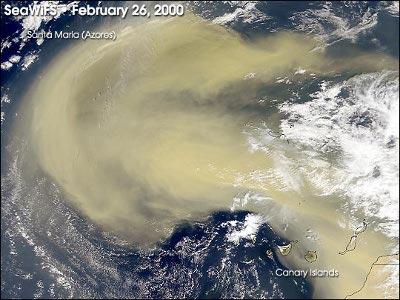SDS & Transport
Atmospheric dust transport
Dust particles with a mass diameter <10 μm have a relatively long lifetime in the atmosphere with respect to gravitational settling (on the order of several weeks ignoring wet deposition due to precipitation), so that they are transported over long distances to the extent of thousands of kilometers [1]. This results in the ability of dust to influence remote ecosystems [2].

Satellite picture from SeaWiFS showing dust transported from the Sahara; NASA
Especially in Africa the transport mechanisms are very efficient, because of sources rich in deflatable material and energetic wind systems [2]; in Asia the frequency of dust storms in arid and semi-arid areas is very high [3]. The dust mobilization process and its frequency are strongly correlated to the meteorological circumstances (e.g. atmospheric depressions affecting North Africa/cyclogenesis [4, 5], precipitation over the Mediterranean [4]). In Asia the transportation process is also correlated to the orographic cyclogenesis [6].
There are numerous evidences on long-range transport of African and Asian dust. The dust transported from the Bodélé Depression (North Africa) can reach South America [7], where it influences the biosphere. The Asian dust frequently moves to Korea and Japan within 2–4 days [6], sometimes it also reaches North America [8].
On their path through the atmosphere, wind-borne soil particles are undergoing extensive changes of their physical and chemical properties [1] due to photochemistry (radiation) [9], cloud processing [10] and mixing with pollutants [11]. For example approximately 40–45% of dust particles are internally mixed with sulphate during their transport in the troposphere [12]. Dust particles are also important reactive surfaces for atmospheric chemical reactions [13].
Publications
[1] J.M. Prospero; Long-range transport of mineral dust in the global atmosphere: Impact of African dust on the environment of the southeastern United States; Proceedings of the National Academy of Sciences 96(7), p. 3396-3403; 1999
[2] S. Engelstaedter, I. Tegen, R. Washington; North African dust emissions and transport; Earth Science Reviews 79, Issues 1-2, p. 73-100; 2006
[3] Y. Shao, C.H. Dong; A review on East Asian dust storm climate, modelling and monitoring; Global and Planetary Change 52, p. 1–22; 2006
[4] C. Moulin, C.E. Lambert, U. Dayan, V. Masson, M. Ramonet, P. Bousquet, M. Legrand, Y.J. Balkanski, W. Guelle, B. Marticorena, G. Bergametti, F. Dulac; Satellite climatology of African dust transport in the Mediterranean atmosphere; Journal of Geophysical Research 103(11), p. 13,137-13,144; 1998
[5] P.L. Israelevich, Z. Levin, J. H. Joseph, E. Ganor; Desert aerosol transport in the Mediterranean region as inferred from the TOMS aerosol index; Journal of Geophysical Research 107, p. 4572; 2002
[6] Y. Chung; On the observations of yellow sand (dust storms) in Korea; Atmospheric Environment Part A, general topics 26, Issue 15, p. 2743-2749; 1992
[7] M.C. Todd, R. Washington, J. Vanderlei Martins, O. Dubovik, G. Lizcano, S. M’Bainayel, S. Engelstaedter; Mineral dust emission from the Bodélé Depression, northern Chad, during BoDEx 2005; Journal of Geophysical Research 112; 2007
[8] S. Fan, L.W. Horowitz, H. Levy II, W.J. Moxim; Impact of air pollution on wet deposition of mineral dust aerosols; Geophysical Research Letters 31; 2004
[9] A.R. Baker, M. French, K.L. Linge; Trends in aerosol nutrient solubility along a west–east transect of the Saharan dust plume; Geophysical Research Letters 33; 2006
[10] N.M. Mahowald, S. Engelstaedter, C. Luo, A. Sealy, P. Artaxo, C. Benitez-Nelson, S. Bonnet, Y. Chen, P.Y. Chuang, D.D. Cohen, F. Dulac, B. Herut, A.M. Johansen, N. Kubilay, R. Losno, W. Maenhaut, A. Paytan, J.M. Prospero, L.M. Shank, R.L. Siefert; Atmospheric Iron Deposition: Global Distribution, Variability, and Human Perturbations; Annual Review of Marine Science 2009, p. 245–278; 2009
[11] R. Arimoto, Y.J. Kim, Y.P. Kim, P.K. Quinn, T.S. Bates, T.L. Anderson, S. Gong, I. Uno, M. Chin, B.J. Huebert, A.D. Clarke, Y. Shinozuka, R.J. Weber, J.R. Anderson, S.A. Guazzotti, R.C. Sullivan, D.A. Sodeman, K.A. Prather, I.N. Sokolik; Characterization of Asian Dust during ACE-Asia; Global and Planetary Change 52, p. 23–56; 2006
[12] D. Trochkine, Y. Iwasaka, A. Matsuki, M. Yamada, Y. Kim, T. Nagatani, D. Zhang, G. Shi, Z. Shen; Mineral aerosol particles collected in Dunhuang, China, and their comparison with chemically modified particles collected over Japan; Journal of Geophysical Research 108, p. 8642; 2003
[13] P.R. Buseck, M. Pósfai; Airborne minerals and related aerosol particles: Effects on climate and the environment; Proceedings of the National Academy of Sciences 96(7), p. 3372-3379; 1999
Publication list in alphabetical order (including publications from above):
bibliography-transport [pdf, 38 kB]
